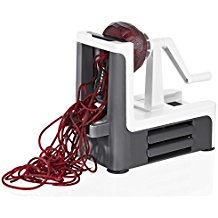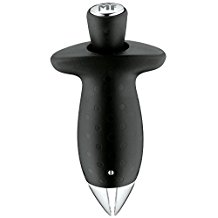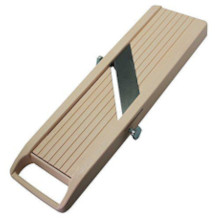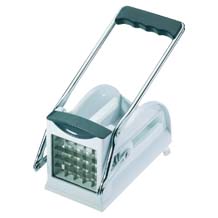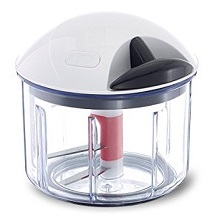Meat slicer purchasing advice: how to choose the right product
- What You Need to Know
- An all-purpose slicer is ideal for slicing fruit, vegetables, bread or meat.
- Electric food slicers require electricity but no effort on the part of the user.
- Most slicers have a serrated blade that is suitable for most foods.
- The power of the slicer should be between 100 and 150 watts.
- Foldable universal slicers are suitable for small kitchens.
A slicer for all occasions
In the kitchen, busy cooks often need time and patience to cut different foods such as meat, vegetables, fruit and bread. If you want to cut effortlessly and evenly, you can use an all-purpose slicer. This is a kitchen appliance that is either electrically or manually operated and cuts various foods into uniform slices of any thickness or thinness in a short time.
The advantage is that freshly sliced food tastes better than pre-sliced, pre-packaged goods because the flavour is stronger. Many foods are also cheaper in the piece than in the pre-sliced version. But with an all-purpose slicer, you not only save money, but also time – after all, slicing is faster than preparing food by hand. For example, you can use the appliance to prepare salads or fruit platters in no time at all.
Despite its name, the universal slicer is not suitable for all foods. Deep-fried foods and meat with bones are usually too hard to be processed properly by the device. The machine may even suffer damage if used for these purposes. Extremely soft foods, such as tomatoes, can fray and then not be cut evenly.
For whom is an all-purpose slicer suitable?
Basically, an all-purpose food slicer enriches every household. In families where fresh food is often cooked, the appliance does well because it cuts larger quantities of food in a short time. This means that family dinners or celebrations with homemade buffets are no problem. It also allows each member of the family to adjust the cut to their individual preferences. For people who cannot wield a knife due to their physical limitations, such as senior citizens, an all-purpose slicer is ideal. Thanks to its easy handling, food can be cut without exerting force. Hobby cooks also benefit from the machine, as they often have to cut a wide variety of foods.
How an all-purpose slicer works
The universal slicer has a so-called cutting carriage on which the desired food is placed. With the help of a rotating wheel on the side of the machine, the user can adjust the thickness of the slices to be cut. A sharp, rotating cutting blade cuts the food as desired. The user has to press the food against the blade. The slices then emerge from behind the blade.
All-purpose slicers with motor
Most all-purpose slicers work with an electric motor. The user does not have to exert any force, as the machine does all the work. A power socket is required for operation. Some of the electric guillotines can be folded away, making them ideal for storage. Due to the motor, however, these machines are considerably louder and more expensive than hand-crank models. On the other hand, they have more power, which is why these machines are recommended for harder foods.
All-purpose slicer with hand crank
A manual food slicer also has its advantages. For example, it is much more environmentally friendly and flexible because it does not require a power socket. Such a device is driven by the user using a hand crank. This requires more time and strength than an electric device. For people with physical limitations, this variant is therefore not recommended. Since the speed of the blade is determined by the user, the risk of injury is lower than with a motorised universal slicer. The lack of a motor also makes a manual universal slicer lighter and more portable.
What you should look out for when buying an all-purpose slicer
If you want to buy an all-purpose slicer, you should pay attention to a few important criteria. Besides the aforementioned difference between an electric and a manual appliance, the blades, cutting width, installation and safety are also relevant.
Knives
The most important element of the universal slicer are the blades. They differ first of all in their grind. Knives with a smooth grind are particularly suitable for cutting wafer-thin slices. They process hard foods, such as all types of salami, extremely precisely. The smooth cutting blades cleanly cut through the fibres of the respective food, ensuring that they do not tear and that the cut is very smooth. Almost every universal slicer has serrated blades as standard. These are equally suitable for all foods.
The quality of the blades is also important. Most cutting blades are made of stainless steel. This material is very easy to clean and lasts a long time. Knives with a non-stick coating are intended for greasy and soft foods, as these do not stick to the cutting blades. However, this coating is not suitable for hard food, such as bread, because it can be damaged by too much friction. Cutting blades with a non-stick coating are only available with a smooth grind. Knives with titanium coating are considered extremely resistant. The hard material is very durable and therefore ideal for universal slicers that are in daily use. If you want knives that are particularly easy to clean, you can opt for electrolytically polished cutting blades. Due to their smooth surface, hardly any food residue sticks to them. They are also very sharp.
When buying, make sure that the blades are replaceable and that this process is easy. In most cases, the appliance already comes with a set of stainless steel knives with a serrated edge. Other knives can be purchased separately.
Mode of operation of the knives
To change the beginning of the sentence: “There are two possible operating modes. With some units, the knife is activated by a push-button that has to be pressed during the entire cutting process. The blade only turns when the button is pressed. This is called momentary operation. This variant poses little risk of injury because the knife stops as soon as the button is released. In contrast, continuous operation involves flipping a switch or pressing a button that activates the knife. The blade only stops when the switch or button is pressed again.
Power
The motor power of an electric universal slicer is between 65 and 170 watts for most machines. The harder the material to be cut, the more power the slicer needs. However, machines with a higher wattage are particularly noisy. The food slicer should have 100 to 150 watts if you want to use it to cut different types of food.
Cutting width
To be able to prepare food in as many different ways as possible, the food slicer should have an adjustable cutting width. Then you can cut bread as well as vegetables, fruit and meat to your liking. The cutting width should be adjustable between 0 and 20 millimetres. Inexpensive models can only be adjusted in a few steps, while higher-priced models allow precise millimetre adjustment.
Installation
Depending on the space you have available for the universal slicer, you should choose either a folding, a free-standing or a permanently installed unit. A foldable model is particularly space-saving and therefore ideal for small flats and single households. When not in use, it can be stored in a drawer. If you have a little more space, you can opt for a freestanding universal slicer. This can be set up flexibly and can therefore change its location at any time. Nevertheless, this variant requires space, which is why it is more suitable for medium-sized to large kitchens. In large kitchens, a permanently installed universal slicer looks good. It is fixed to the kitchen counter by its screws and is therefore particularly stable. However, it cannot be moved around easily.
Price
All-purpose slicers are available in different price categories. The higher the performance, the more money you have to spend. The quality of the material also influences the price. Cheaper devices are usually made of plastic, do not last as long and have little power. For infrequent use, such a device for about 50 euros can be sufficient. If you want a very powerful appliance for any kind of food, you can expect to spend between 200 and 400 euros. Such all-purpose slicers last a particularly long time and are made of high-quality material, which is why they are not as susceptible to damage.
Safety
Since the blades of an all-purpose slicer are very sharp, some safety mechanisms are necessary to reduce the risk of injury. Many machines therefore have a safety circuit that prevents them from being switched on accidentally. This function is particularly important in households with children.
When running for a long time or with great resistance, the motor of the universal cutter can become very hot and overheat. An overheating protection curbs this danger by automatically switching off in case of overheating. This makes the motor last longer and minimises the risk of burns.
Material
ll-purpose slicer is made of either plastic or stainless steel. A machine made of plastic is not very recommendable, as it is not as durable and stable as models made of stainless steel. The easiest to clean is a machine made of stainless steel.
Accessories
Users of an all-purpose slicer can purchase extras that increase the utility value of the appliance. To prevent the cut food from spreading over the work surface and possibly falling onto the floor, a catch tray should be used. In most cases, this is included with the appliance.
Additional knives are useful if you want to cut different foods. A knife sharpener is also practical to keep the knives sharp at all times.
Are all-purpose slicers also available for left-handers?
Most all-purpose slicers have the cutting guide on the right, which is why they are designed for right-handers. However, there are also versions with a left-hand cutting guide that are more suitable for left-handers. Some manufacturers even offer special all-purpose slicers with cutting guides on both sides.
How to clean an all-purpose slicer
To ensure that the appliance lasts a long time and remains hygienic, it should be cleaned after every use. Before cleaning, make sure it is switched off and unplugged. First remove all food residues from the blade, cutting carriage and drip tray to prevent bacterial growth and corrosion and to ensure that the blade continues to cut properly. If the cutting carriage is removable, this makes cleaning much easier. Wash it and the removable blade carefully with soapy water. The individual parts of an all-purpose slicer are not usually dishwasher safe. You will find all the important information about cleaning in the instructions for use of the appliance.
The cogwheel of the blade and the motor axle should also be regularly rubbed with grease. Sharpen or replace the blade as necessary to ensure that the cutting result always remains satisfactory.

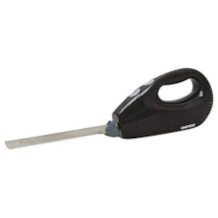
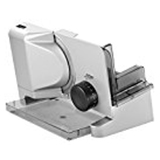
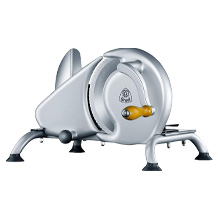

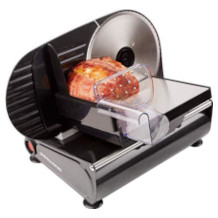
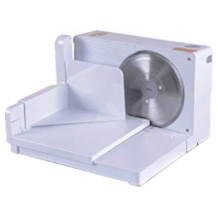



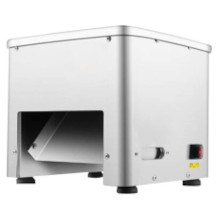
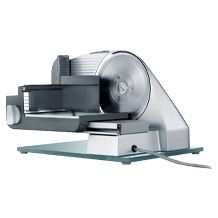





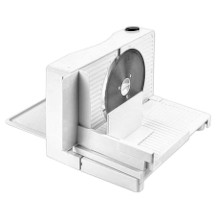


 4,631 reviews
4,631 reviews
